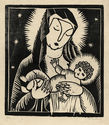
19th, 20th & 21st Century Fine Prints
707-546-7352 · fax 707-546-7924 · web: www.annexgalleries.com · email: artannex@aol.com
Ilonka Karasz Biography
Ilonka Karasz
American
1896–1981
Biography
Artist and designer Ilonka Karasz Nyland was born on July 13, 1896 in Budapest, Hungary. She attended the Wiener Werkstatte-inspred Hungarian Royal Academy of Art and Crafts as a teen with her sister, noted designer Mariska Karasz, two of the first women to be admitted to the school. In 1913 she immigrated to the United States at age seventeen, settling in New York City's Greenwich Village. Within two years she had co-founded the European-American artists collective Society of Modern Art, was teaching textile arts at the Modern Art School, and had been commissioned to design an advertising campaign for the Bonwit Teller department store. In 1920 she married Dutch chemist Willem Nyland and they built a house together in Brewster, NY which was featured in a 1928 House Beautiful magazine.
Through the Society of Modern Art collective's periodical The Modern Art Collector she published several of her designs, including theater posters, cover designs, and illustrations. Karasz took inspiration from folk art, translated into Modernist styles that she applied to textiles, ceramics, furniture, silverware, wallpaper, toys, and more. She began entering her works in exhibitions in 1916, winning prizes and recognition in Women's Wear and elsewhere, and gaining a reputation as a leading textile designer by 1918.
Karasz's prolific career was often spurred by a desire to experiment with tools many avoided. Her success in the textile world was partially due to her willingness to work with the difficult Jacquard loom, used for upholstery, which opened the doors to transportation commissions. Dupont-Rayon hired her to improve the feel of rayon in the 1920s, revolutionizing the then-new fabric and helping foster its popularity in high fashion. The '20s and 30s also saw her highest production of metalsmith work, including silverware, jewelry, and furniture. Inspired by the De Stijl movement, this work was often minimalist and planar, and in 1928 she was the only woman given an entire room for her designs in the American Designer's Gallery exhibition. Interestingly, one of the "rooms" designed for the show was a nursery, considered the first nursery to be shown in a designer showcase; she followed the success of this work with lines of washable fabrics and convertible furniture, and rooms designed for children's intellectual development. An illustrator, she took commissions from various American periodicals and book publishers, and designed 186 New Yorker covers throughout her career, beginning in 1924. Despite her prolific and often revolutionary work, Karasz is often overlooked in the canon of Modern American art.
Ilonka Karasz died on May 26, 1981 in Warwick, New York. A retrospective of her work was mounted at the New York gallery Fifty/50, and the Cooper Hewitt Museum holds a large collection of her design pieces, from rugs to wallpaper to metalware.







